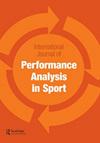视力障碍柔道运动员时间战斗结构的性别和体重类别差异
IF 1.6
4区 教育学
Q1 Health Professions
International Journal of Performance Analysis in Sport
Pub Date : 2022-02-14
DOI:10.1080/24748668.2022.2039089
引用次数: 4
摘要
摘要视觉障碍运动员的时间柔道格斗结构研究(六)有待进一步研究。本研究的目的是确定患有VI的男性和女性柔道比赛的时间结构,并确定性别之间、各自体重类别内以及不同比赛时间之间的差异。样本由参加2018年IBSA柔道世界锦标赛的所有VI柔道选手(172名男子和95名女子)组成。通过观察方法,我们分析了所有的战斗(n=365)。为了获得结果,我们使用了不同的分析技术:描述性、单因素方差分析、显示独立性的t检验、卡方、效应大小和t模式分析。显著性水平为ρ≤.05。研究结果按性别和体重类别定义了一个时间结构,使柔道专业人员能够为运动员计划精确和充分的训练。我们得出的结论是,患有VI的男性和女性在柔道比赛的时间结构、各自的体重类别和不同的比赛分钟内存在差异。战斗的时间结构在女性身上发生了更显著的变化,在不同的体重类别中,男女的变化也不均衡。本文章由计算机程序翻译,如有差异,请以英文原文为准。
Sex and weight category differences in the temporal combat structure of judokas with visual impairment
ABSTRACT The study of the temporal judo combat structure of athletes with visual impairment (VI) needs further research. The objectives of the study were to determine the temporal structure of combat of judo in men and women with VI and establish differences between sexes, within their respective weight categories and between the different minutes of combat. The sample was formed by all the judokas with VI who participated in the 2018 IBSA Judo World Championship (172 men and 95 women). Through observational methodology, we analysed all the combats (n = 365). In order to obtain the results, we used different analytical techniques: descriptive, one-way ANOVA, t-test to show independents, chi-square, effect size and T-Patterns analysis. The level of significance was ρ ≤ .05. The results define a temporal structure by sex and by weight category that allows the judo professionals to plan precise and adequate trainings for the athletes. We conclude that there are differences in the temporal structure of judo combat within the men and women with VI, within their respective weight categories and within the different minutes of combat. The temporal structure of combat has changed more markedly in women and unevenly in the different weight categories for both sexes.
求助全文
通过发布文献求助,成功后即可免费获取论文全文。
去求助
来源期刊

International Journal of Performance Analysis in Sport
SPORT SCIENCES-
CiteScore
4.70
自引率
4.80%
发文量
38
审稿时长
>12 weeks
期刊介绍:
The International Journal of Performance Analysis in Sport aims to present current original research into sports performance. In so doing, the journal contributes to our general knowledge of sports performance making findings available to a wide audience of academics and practitioners.
 求助内容:
求助内容: 应助结果提醒方式:
应助结果提醒方式:


